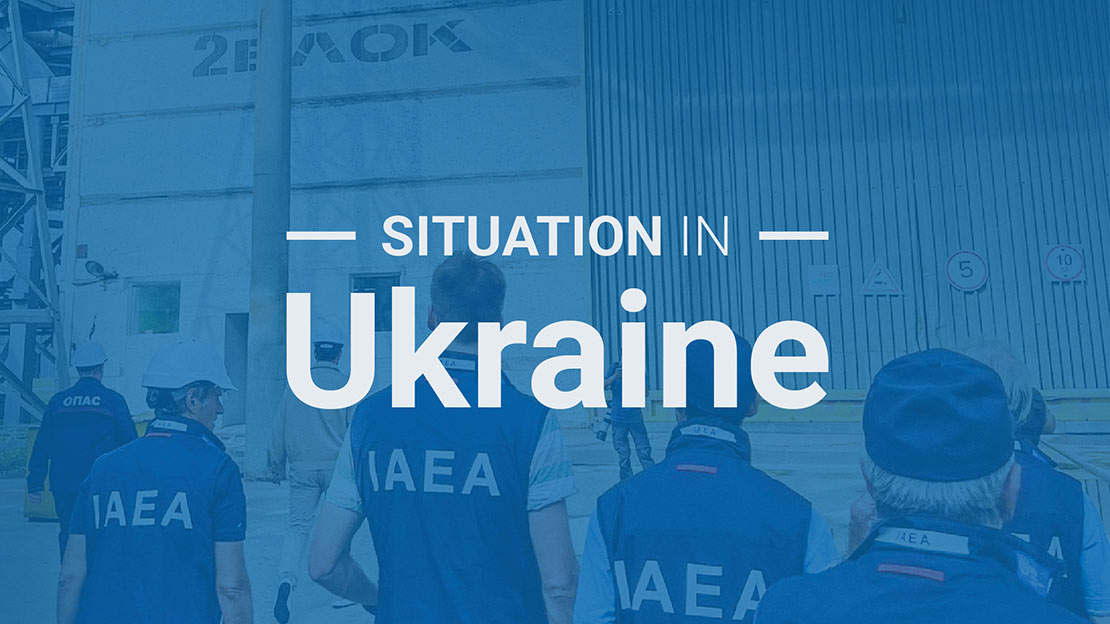Update 323 – IAEA Director General Statement on Situation in Ukraine
The Zaporizhzhya Nuclear Power Plant (ZNPP) was successfully re-connected to Ukraine’s electrical grid today after a month-long outage, following repairs carried out under the protection of a local ceasefire negotiated by the IAEA and observed by its teams on the ground, Director General Rafael Mariano Grossi said.
The restoration of off-site power to Europe’s largest nuclear power plant – for the past several years located on the frontline of the military conflict – marks a significant positive step as last month’s loss of all external electricity supplies had further stoked concerns about the fragile nuclear safety and security situation at the site.
“Today is a rare, good day for nuclear safety and security in Ukraine and beyond, although the overall situation of course remains highly precarious. After exactly one month without any off-site power, the Zaporizhzhya Nuclear Power Plant is once again receiving the external electricity it needs to cool its six reactors and spent fuel,” Director General Grossi said.
“Since the plant was disconnected from its last off-site power line on 23 September, we have been working intensively with the Russian Federation and Ukraine to create the necessary security conditions for repairs to be carried out on both sides of the frontline. Despite the war, they both agreed that it was vital to restore off-site power and cooperated constructively with us to make that happen,” he said.
In the reconnection process followed by an IAEA team on the ground and from the ZNPP’s electrical control room, the newly repaired 750 kilovolt (kV) Dniprovska power line was energised by the Ukrainian grid operator at 09:30 local time and the ZNPP 750kV switchyard was fully powered two minutes later. The ZNPP then began gradually restoring power to its six reactor units and the remainder of the site.
At 13:00 local time off-site power was restored to the whole ZNPP site and the last of the emergency diesel generators - that had supplied back-up power for the past 30 days – was turned off, ending the tenth and by far the longest complete loss of off-site power suffered by the plant during the conflict.
“What was once virtually unimaginable – a nuclear power plant regularly losing off-site power – has unfortunately become a common occurrence during this devastating war. However, this was the most challenging loss of power event we have experienced so far. I would especially like to extend my thanks to the technicians – on both sides of the frontline – who have been working hard in recent days to restore power in very difficult circumstances,” Director General Grossi said.
Under IAEA monitoring, work to repair the Dniprovska and another damaged power line – Ferosplavna-1 – got underway last weekend after the establishment of temporary ceasefire zones on opposite sides of the Dnipro River. As both zones are in an active combat area, de-mining specialists conducted extensive clearance work before the actual repairs could begin.
The IAEA team based at the ZNPP monitored the work at the damaged section of the Dniprovska line, where technicians replaced several broken cables before re-attaching them to the transmission towers. A damaged metal support arm of one transmission tower was also replaced, and new insulators were installed in several towers.
The IAEA is continuing to coordinate with both sides to pave the way for further repairs of the 330 kV Ferosplavna-1 line, where additional damage outside the ceasefire zone was identified this week. The IAEA was informed that two broken transmission cables were found 1.8km from the electrical switchyard of the Zaporizhzhya Thermal Power Plant, located near the ZNPP.
Before the conflict, the ZNPP had access to ten power lines. In recent years, that was reduced to two, of which Ferosplavna-1 was lost on 7 May while the Dniprovska line was disconnected late last month. Both sides blamed the damage on military activity.
The plant’s six reactors have not produced electricity for more than three years and have been shut down but they still require power to run their cooling pumps and for other nuclear safety and security equipment. Over the past month, the plant has relied on emergency diesel generators for the electricity it needs.
“There is still much work to do to further reduce the risks of a nuclear accident. The next step is to complete the repairs of the Ferosplavna-1 power line and then to prevent future loss of power events,” Director General Grossi said.
“I once again call for full compliance with the IAEA’s Five Concrete Principles to prevent a nuclear accident at the Zaporizhzhya Nuclear Power Plant. The third principle states that off-site power to the plant should not be put at risk and that all efforts should be made to ensure that off-site power always remains available and secure,” he said. “The IAEA will continue its indispensable work at the Zaporizhzhya Nuclear Power Plant and the other nuclear sites in Ukraine until this devastating war is over.”
